There’s something so bizarrely… trans, dare I say, about Spike the first moment he appears on screen.
(Stay with me here.)
Spike, recurring vampire antihero and villain on Buffy the Vampire Slayer, drives into frame and knocks down a “Welcome to Sunnydale” sign with his vintage car as his very first entrance in Buffy Season 2, Episode 3: “School Hard.” He does not fit in; he so clearly, so loudly, does not want to.
His boots and his jacket are a little too big. He walks into a room of senior vampires we’ve gotten to know as scary, faceless bureaucratic men and is a head shorter than the one in charge. He interrupts the baddies monologuing with a youthful, devil-may-care air that’s brighter than anything in the room. He’s older than anyone in the room (except the Anointed) and looks about 10 years younger. He knows his place from the minute he stomps out of his unnecessarily scary muscle car, in a proto-CW-like parody of masculinity, smoking and rolling his eyes. He’s an almost cartoonish bad boy, convincing only because we find out he is a real threat. He is instantly grounded and given audience attention. He’s doing just a little too much to be a man.
Then the contradictions start.
Drusilla appears, Spike’s monstrous vampire face melts away, and he stands still, gazing softly at the love of his life. In this moment, the audience sees a completely different layer to a character we’ve been so sure of for the few minutes we’ve known him. We immediately clock that there’s something different here; he’s not quite like the other vampires.
He’s not Angel—not dark or brooding or quietly, stoically masculine—Spike is boisterous and snarky and a self-professed braggart. Victorian slam poet through and through. Angel is straight-laced. Spike is camp. (This is, of course, only speaking of Buffy and not Angel. Both characters undergo a significant amount of change over theory time on both shows, particularly the spinoff.)
Watching Spike stomp onto the screen was the first time I laid eyes on a character with such confident gender nonconformity.
The Aesthetics of Punk Vampires
I didn’t know what it was, at the time. I just knew I was obsessed with Spike. It’s a feeling a lot of genderqueer people describe as a crush, at first, when we’re young, especially if we were raised and socialized as young girls who were expected to have crushes on hot boys.
James Marsters, who plays Spike, is without a doubt a very handsome man. That handsomeness is, however, somewhat delicate. He has high, structured cheekbones and a slim frame in Buffy. With the unbelievably gentle expression with which we see his human face for the first time, Spike has an almost feminine beauty.
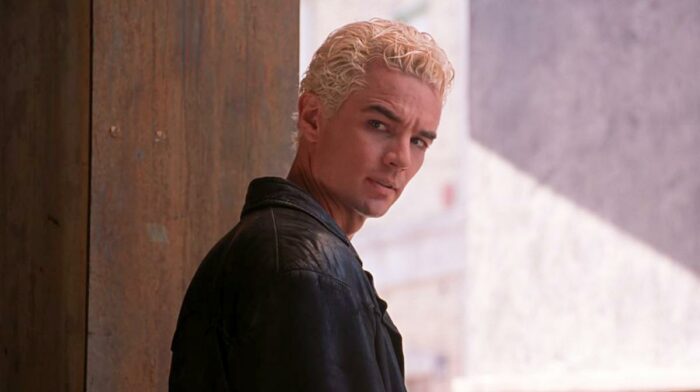
Spike’s costume also accentuates this combination of masculinity and femininity. His instantly recognizable black leather trench coat actually came from the second slayer he killed in the 1970s. While it’s probably a men’s coat, the fact that he took it from a woman, and that it’s still somehow several sizes too big for him, gives it a grungy, androgynous style. Paired with bleach-blonde hair, open button-downs, a chain necklace, a number of silver rings, painted black nails that mimic his girlfriend’s french tips, and Marsters’ striking features… he could be mistaken for a butch lesbian.
Marsters is also, surprisingly, only 5’9”, making him a decent 7” taller than Sarah Michelle Gellar (Buffy), for sure, but three inches shorter than both David Boreanaz (Angel) and Anthony Stewart Head (Giles). Discovering that I’m taller than Spike gave me a bit of a shock. He seems to take up so much space in the room that you’d expect him to tower. He doesn’t. He’s a mess of contradictions. It’s utterly compelling.
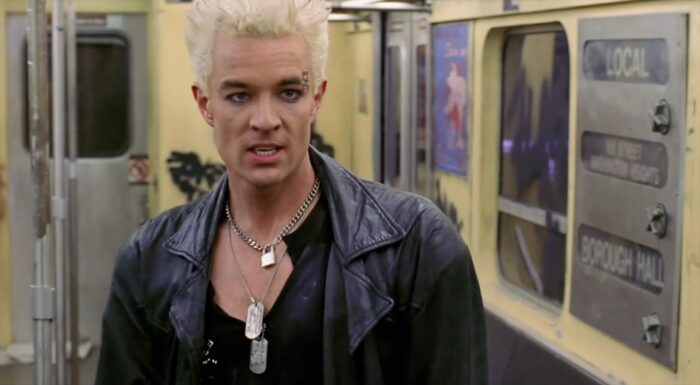
Spike is masculine in a feminine way. He is even, sometimes, feminine in a masculine way. All of these things are rooted in his confidence, that sexy devil-may-care attitude, and the aesthetics he provides as someone teetering the edge of gender nonconformity.
This specific, self-referentially Billy Idol-esque aesthetic radiates a type of queerness that I recognized within myself, even if I didn’t know it yet at the age of 14. It was aspirational. Spike was cool and sexy and hard, and yet at the same time didn’t look like anyone I had ever seen before.
At the end of his first scene in “School Hard,” when Spike dares the other vampires to kick him out of Sunnydale, not a single one steps up to fight. His strength is in his unpredictability: he could be punching a vamp twice his size in one minute and tenderly letting Drusilla lick blood off his cheek in the next.
These contradictions and surprises are what make him such a driving force for the audience and the characters. For me, it makes him the subject of much gender envy.
Allow me to describe the term. “Gender envy” is a colloquial phrase used to describe the feeling of, quite literally, envying someone else’s gender expression; wanting to be or look like that person. I didn’t know those words when I watched Buffy for the first time, but that was exactly the feeling I was having. Indescribable and exciting. I wanted that.
“…effulgent.”
To me, Spike’s backstory reinforces his queer “flavoring,” if you will. Before Spike was a vampire, he was a failed Victorian poet hopelessly in love with an upper-class woman named Cecily. His bad writing and birth name earned him the moniker: “William the Bloody Bloody Awful,” which he would reclaim as “William the Bloody” in his vampire heyday. He would eventually completely rename himself to “Spike” after discovering a penchant for torturing victims with railroad spikes.
That concept of reclaiming one’s (quite literal) “dead” name post metaphorical-transition, or at least after Spike became somebody he wanted to be, is not anything new to members of the LGBTQ+ community. There’s a reason vampires, werewolves, and other horror monsters and villains often end up becoming accidental queer icons. They can transform pain into beauty, trauma into power; their disruptive or backwards moral codes allow them to have fully realized confidence in a society that does not accept them.

I don’t know if I made that connection way back at age 14, but I remember being captivated by the soft, bullied William’s transformation into a sexy androgynous “give-no-shits” punk vampire. The story pulled at me because, just a little bit, I wanted to be like him (sans the murder).
(Side note—while Spike is decidedly canonically straight, there are some fun little winks when he joins the cast of Angel in Season 5 and more of his backstory is unearthed, particularly in the episode “The Girl in Question,” in which he and Angel go to Italy to hunt down a centuries old monster that is supposedly dating Buffy. It’s implied that this monster, known simply as “The Immortal,” had a threesome with Darla (Angelus’s longtime beau) and Drusilla back in the day, to which Angelus and Spike reply, “You never let us do that!”)
The relationship between Drusilla and Spike colors his gender nonconformity as well. Drusilla radiates unstable, strong, powerful energy from an extremely stereotypical feminine aesthetic. Spike, past his sarcasm-laden masculine veneer, is discovered to be gentle and to be able to love, as nearly as something without a soul can love. It’s not a stereotypically masculine trait. Spike is loving and soft with her in a way that few men outside of the heroes get to be in Buffy. He is (what the kids these days might call) a simp.
Spike goes so far in his passion for Drusilla as to join Buffy at the end of Season 2 to defeat Angelus—his once father/brother-figure. Crazy evil or not, Spike wears his heart on his sleeve. It’s refreshing, exciting, and keeps the audience on their toes. Throughout his tenure on Buffy, Spike does unfortunately become more predictable as his elevated passions become much more concentrated by way of his eventual “love” for Buffy, but that heightened, loving madness is one of his greatest motivations. He is—bizarrely—the show’s only use of the “mad woman” trope on a man (the women of the Whedonverse get that treatment quite often, so it’s nice to see him flip the script this one time).
This passionate drive makes Spike one of the more insightful members of the Scoobies (Buffy’s term for the main gang) both in his pre-good-guy appearances in Seasons 2 and 3, and when he joins them in Season 4. One of his most famous lines is also one of the show’s most romantic, in which Spike tells Buffy and Angel that their attempt to remain friends despite their feelings is futile:
“You’re not just friends. You’ll never be friends. You’ll be in love till it kills you both. You’ll fight, you’ll shag, and you’ll hate each other till it makes you quiver, but you’ll never be friends. Love isn’t brains, children. It’s blood. Blood screaming inside you to work its will. I may be love’s bitch, but at least I’m man enough to admit it.”
Jesus Christ.
This emotional honesty not only makes Spike unique as a villain, but as a man. He knows that love is what drives him. He’s openly passionate and confident in his masculinity because he doesn’t have anything to hide. In that admittance, he doesn’t have to overcompensate for his past at all. He is simply himself.
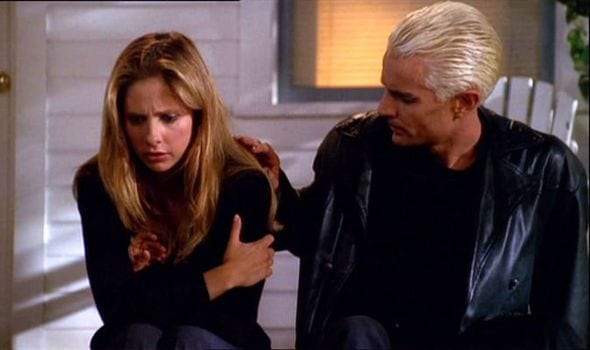
When Spike is micro-chipped in Season 4, he is prevented from harming humans and reluctantly joins Buffy’s group. He is stuck in a middle ground between human and vampire. He can’t kill the way he used to, but he doesn’t have a soul. He continues to commit the odd atrocity here and there. Eventually, after attacking Buffy in Season 6, Spike becomes disgusted with himself and goes through torturous magical trials in order to regain his soul. Even then, he is torn in a half-man, half-monster state where he cannot find peace. Buffy says this to him as they fight viciously before consummating their sexual relationship in the S6 episode “Smashed:” “Can’t be a human, can’t be a vampire…”
“Where The Hell Do You Fit In?”
In my junior year of high school I went to New York Comic Con for the second time. My friend (also Natalie) and I excitedly mined through all the things we nerded over together, trying to decide our second pair cosplay. The year before we’d gone as Quicksilver and Scarlet Witch from the recently released Avengers: Age of Ultron (it would only dawn on me last year—five years later—why so many characters I yearned to present as were flirty queercoded men). We settled on Spike and Drusilla.
The shirt, pants, necklace, and boots I owned or could borrow. I was excited to spray my hair platinum blonde and cosmetically draw on James Marsters’ little eyebrow scar and killer cheekbones. More than anything, I was excited to own the coat.
The day it arrived, I put it on in the mirror over my black t-shirt and jeans. Something deep in my heart did an inexplicable happy flutter. It was somehow how I was supposed to look. I never saw myself as a punk or a badass (except for the rebellious phase we all had for 6–10 months in middle school), but looking like Spike… looking like a queerish, slightly feminine, flirty, passionate, confident man… something about that sat differently.
Spike’s coat is still in my closet. I wear it on cold windy days when a full-length leather duster is a benefit, and I’ve found a way to rope it into at least two other costumes (Tonks from Harry Potter and Charlize Theron in Atomic Blonde come to mind). I intend to hang onto it as long as it holds together, and I’ll hang onto the replacements Wolfram & Hart Italy provide to me once it falls apart after years of wear.
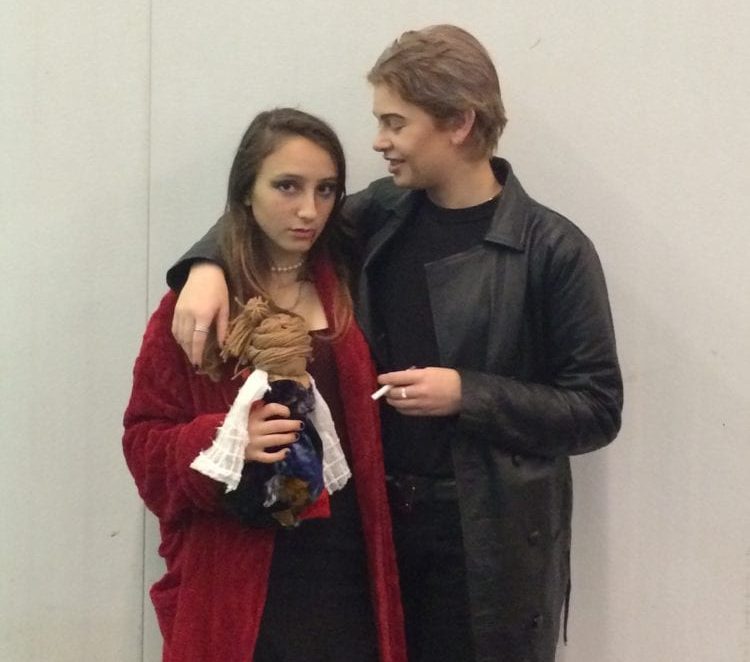
At the end of “School Hard,” Spike endears himself to the audience forever by murdering the uber-annoying fan-despised presumed Big Bad of Season 2—the Anointed—only three episodes in, meta-textually inserting himself as the Big Bad. He doesn’t play by the rules: “from now on, we’re gonna have a little less ritual, and a little more fun around here!” He taught me how to play on my own terms. How to be hot and cool and self-assuredly passionate. How to rock a sick black leather duster, and to just eat the people who don’t like my poetry.
There’s a lot of gender f*ckery in Buffy and Angel, particularly when it comes to gender roles and expectations (Buffy’s whole personality is basically the thesis for the show). There’s also about a million different interpretations of each character from the perspectives of hundreds of queer fans over the years (check out some other great takes from this month). Especially in the light of recent discussions about Joss Whedon’s behavior and the impact he had on his colleagues, it’s important to elevate the work of every single other brilliant creative mind who impacted the Buffy that we know and love.
Spike definitely wasn’t written as a queer icon. That doesn’t change how the coat makes me feel.

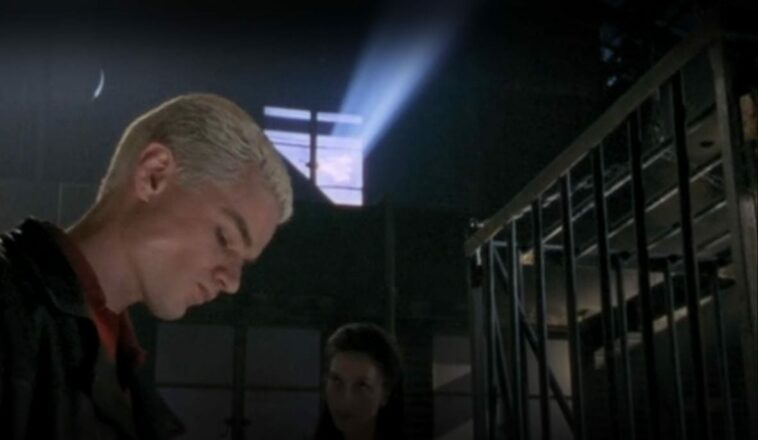
“Angel and me have never been intimate…except that one time…”
Spike may not be queer-coded, but it’s not like there were never exceptions, I’m just saying. 😉
Après ça ne veut pas dire qu’il aime les hommes non plus 😂
This is beautiful. Thank you for sharing